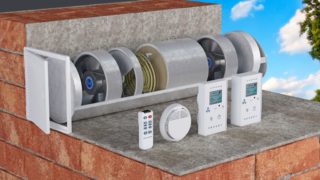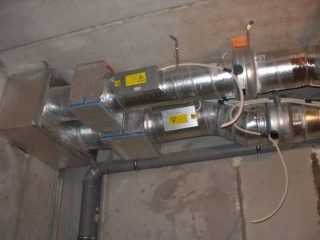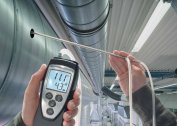Modern forced-air ventilation with heating was designed to create a comfortable microclimate inside residential, office and industrial premises. The presence of such a system makes it possible to adjust the temperature and the number of air flows taking into account the needs, regulate the modes and select them for specific conditions. Before installing ventilation, it will be useful to familiarize yourself with its types and their features, study in detail the principle of operation and learn the main details.
Determination of supply-type ventilation with heating
The difference between fresh air ventilation and standard systems is that it takes air masses from the outside. As a result, the atmosphere in the room not only warms up and cools, but also is additionally saturated with oxygen. The installation of such a ventilation system is needed in rooms where cleaned and heated air is constantly required. It is placed in apartments, private houses and in the workplace. Due to the special design, the used and heated air flows inside it are not mixed with each other. The heating valve is often mounted in the walls with plastic windows in the house, since they inhibit the natural ventilation processes. The list of elements of such a system includes:
- an air intake grille that acts as a protective barrier for garbage and is also decorative;
- heated inlet valve to block cold air in winter and hot in summer;
- filters for purification of warmed air;
- Electric heating elements and water heater.
The supply standard fan with heating in the system is supplemented by a recuperator, a silencer and diffusers. The ventilation design depends on the type and installation method of the entire system.
Varieties of ventilation
Supply ventilation with heated air for a house or apartment is divided into two types: central and compact. Each species has its own characteristics and differences.
Central
Fans with heating carried out using an electric or water heater are responsible for the temperature of the flows. The first option is powered by the mains, the second is built into the central heating system. Some appliances are supplemented by recuperators that perform heat exchange between the air coming in from the street and the warmed air currents going out. The central system is considered the most functional, but it requires more space for placement, installation should be carried out by specialists, which entails significant costs.
Compact
A small-sized system or breather is a small device for issuing fresh air flows into a room, which is installed on the wall. Inside it is a ceramic heating element that heats the incoming air flow and is supplemented by a climate control option that sets the desired temperature. The device helps purify the air with a three-level filtration system. It does not let out particles of dirt, dust, soot, pollen, microbes and allergens, which makes the compact system an ideal choice for creating an environmentally friendly microclimate. Installing a breather takes no more than an hour, while not requiring special effort and serious financial costs.
Advantages and disadvantages of the system
The ventilation system of a home or industrial type has its pros and cons, which must be taken into account before installation. The list of its advantages includes:
- the possibility of air circulation regardless of weather conditions and indoor climate in the room;
- saving costs for gas or electric heating in the winter when installing the supply and exhaust system, supplemented by recovery;
- the presence of cleaning filters;
- no need for constant monitoring due to automatic operation.
The air heater in any ventilation system has its drawbacks, which usually include increased noise, the impressive dimensions of the system and the need to allocate additional space for it, as well as create a project diagram.
Principle of operation
The ventilation system operates according to a standard and simple principle. At the initial stage, the air outside passes through the air intake, supplemented by a plastic grill, which prevents the ingress of contaminants, insects and fluff, but does not interfere with the flow of air. After the air masses go through a special through channel or duct. The walls of such a channel are additionally insulated from the inside of the mine with the help of noise and heat insulation pipes made of plastic, treating each joint with a sealed composition to protect the walls from freezing.
At the joints of the duct with the base of the device, a damper is mounted on the automation. It automatically closes after turning off the appliance to prevent the entry of cold air into the room that needs to be heated. It will also be closed if the incoming air flow deviates from the norm - its temperature should not fall below -40 degrees. While passing through the heater, the air temperature rises to the required level using the climate control function. The owner can specify the required temperature value for air heating, and it will remain at this level.
Due to the optimal design, the system in which the exhaust air is heated does not provoke drafts even in the cold season. The temperature will always be maintained at the right level without control by the user.
Ways to control air heating
You can control the air heating system as part of the supply ventilation of any type in manual or automatic mode. Most modern devices are equipped with automation, but some of them are controlled by the standard principle manually.
Manual mode
With manual control on any device for heating, a set of buttons is provided with which you can adjust the temperature, turn the device on and off, and adjust program settings to specific parameters. Such control is intended for those who plan to use only the basic options of the ventilation system without the need to connect a working application to it.
Auto mode
If desired, the device can be connected to a smart climate system called MagicAir and run in automatic heating and control mode. As a control center, a smartphone is used on which the application is installed. It can be used to measure microclimate parameters, including humidity and air temperature, as well as its carbon dioxide content.
All necessary settings are set and changed directly from the device through the application. It helps to normalize the content of carbon dioxide and other substances in the atmosphere of the room, and also optimizes the operation of the ventilation system.The user only needs to master the interface and select the ideal parameters for his supply ventilation, corresponding to a specific room. After that, the base station with the application will independently transmit commands to the device, switch its speeds, control heating, turn it on and off as necessary.
It is easier to control the air intake system into which the air heater is built-in remotely. The app helps save time on manual control and lower energy costs.
Valves and equipment for supply ventilation
The supply ventilation system with heated air includes several elements, the quality of its functioning as a whole depends on them:
- air filter;
- shut-off valve;
- heating part;
- fan;
- silencer
The most important details are the air shut-off valve, filter and heating elements. Due to the presence of a valve, air will enter the system only when necessary.
The filter element helps to completely clean the air masses entering the system and to prevent particles of dust and dirt from entering the room atmosphere. The presence of a fan allows air to enter the room. If this element is inactive, mass collection will not be carried out.
 When choosing a fan, pay attention to the type and level of noise during operation, its dimensions, performance, as well as the presence or absence of a check valve.
When choosing a fan, pay attention to the type and level of noise during operation, its dimensions, performance, as well as the presence or absence of a check valve.
In addition to the main details in the system for heating the supply and main air there is a ventilation shield, which is also called a cabinet. It houses automation and parts for controlling actuators.
The ventilation system cannot function without an air duct, which can be made of plastic, metal or perforated fabric. When choosing it, special attention is paid to the cross-sectional area, full compliance with the sanitary standards of a particular room and compliance with fire safety requirements.
Additionally, during installation, shaped parts of the system are used: elements for branching, joining, bends and connecting other parts to air ducts. To fix the part, you need a perforated tape, the quality of which must be given special attention, ventilation ducts are also fixed with special clamps. To ensure good air exchange in the ventilation ducts, filters, air heaters, silencers, dampers and valves, duct coolers are installed.








